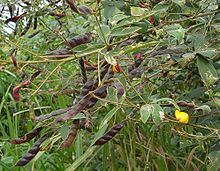Mujje Tulye from Uganda/A West Nile recipe: Dek Ngoo
West Nile
[edit | edit source]
1. + 2. - original West Nile District until 1950s
1. - West Nile district 1960s - 1970s
2. - former East Madi District (later Adjumani District) since 1970s
West Nile sub-region is a region in North-western Uganda. It received its name from being located on the western side of the Albert Nile.
It is bordered by the Democratic Republic of the Congo to the south and west, by South Sudan to the North and by the Albert Nile to the east. The town of Arua, is the largest town in the sub-region.
West Nile sub-region consists of the following districts, as of February 2014: Adjumani District, Arua District, Koboko District, Maracha District, Moyo District, Nebbi District, Yumbe District and Zombo District.
Dek Ngoo, a west Nile recipe
[edit | edit source]
Dek Ngoo consists of pigeon peas with peanut butter, a delicacy from Gulu. It is best served with posho (Ugali), millet bread (Kalo) or sweet potatoes (layata). It can be eaten as a deep or a soup. Shear nut oil (moo yaa) can be used to improve its taste.
Ingredients
[edit | edit source]- 1 cup of split pigeon peas
- peanut butter
- salt
- magadi (rock salt)
Procedure
[edit | edit source]- soak split pigeon peas in 1.5ml of warm water for one hour
- the peas should be plumped up and soft and the covers that were on some of them should be coming off.
- sieve the water into sauce pan (all the flavor is in there), put the water on the stove to start boiling.
- wash the peas remove all the covers, they will float easily because of the earlier soaking. Put the peas in to the water you placed on the stove add salt and rock salt
- let it boil until the peas are mushy. There will be a froth foaming at the top while it boils remove it with a ladle.
- when the peas are mushy add peanut butter and mix. There is a special contraption we use called ugwech, but you had use a hand blender it is easier on the muscles and quicker results.
- the peanut will make the soup thick so please add to your satisfaction for thick or thin. If it becomes too thick you can add HOT water to loosen the mixture.
More on split pigeon peas
[edit | edit source]

The pigeon pea (Cajanus cajan) is a perennial legume from the family Fabaceae. Since its domestication in South Asia at least 3,500 years ago, its seeds have become a common food grain in Asia, Africa, and Latin America.
Today, pigeon peas are widely cultivated in all tropical and semitropical regions. Pigeon peas can be of a perennial variety, in which the crop can last three to five years (although the seed yield drops considerably after the first two years), or an annual variety more suitable for seed production.
The crop is cultivated on marginal land by resource-poor farmers, who commonly grow traditional medium- and long-duration (5–11 months) landraces. Short-duration pigeon peas (3–4 months) suitable for multiple cropping have recently been developed. Traditionally, the use of such input as fertilizers, weeding, irrigation, and pesticides is minimal, so present yield levels are low (average = 700 kg/ha). Greater attention is now being given to managing the crop because it is in high demand at remunerative prices.
Pigeon peas are very drought-resistant, so can be grown in areas with less than 650 mm annual rainfall. World production of pigeon peas is estimated at 4.3 million tons2. About 82% of this is grown in India. These days it is the most essential ingredient of animal feed used in West Africa.
Pigeon peas are both a food crop (dried peas, flour, or green vegetable peas) and a forage/cover crop. In combination with cereals, pigeon peas make a well-balanced human food. The dried peas may be sprouted briefly, then cooked, for a flavor different from the green or dried peas. Sprouting also enhances the digestibility of dried pigeon peas via the reduction of indigestible sugars that would otherwise remain in the cooked dried peas.
Sources